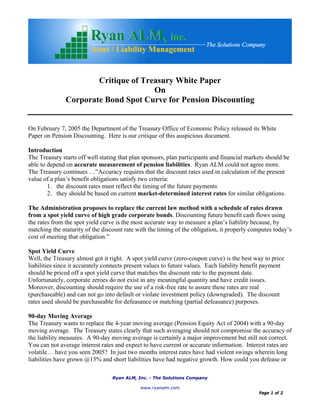
A critique of treasury whitepapeer on corporate bond spot curve for pension discounting by ryan alm
- 1. Ryan ALM, Inc. - The Solutions Company www.ryanalm.com Page 1 of 2 Critique of Treasury White Paper On Corporate Bond Spot Curve for Pension Discounting On February 7, 2005 the Department of the Treasury Office of Economic Policy released its White Paper on Pension Discounting. Here is our critique of this auspicious document. Introduction The Treasury starts off well stating that plan sponsors, plan participants and financial markets should be able to depend on accurate measurement of pension liabilities. Ryan ALM could not agree more. The Treasury continues …”Accuracy requires that the discount rates used in calculation of the present value of a plan’s benefit obligations satisfy two criteria: 1. the discount rates must reflect the timing of the future payments 2. they should be based on current market-determined interest rates for similar obligations. The Administration proposes to replace the current law method with a schedule of rates drawn from a spot yield curve of high grade corporate bonds. Discounting future benefit cash flows using the rates from the spot yield curve is the most accurate way to measure a plan’s liability because, by matching the maturity of the discount rate with the timing of the obligation, it properly computes today’s cost of meeting that obligation.” Spot Yield Curve Well, the Treasury almost got it right. A spot yield curve (zero-coupon curve) is the best way to price liabilities since it accurately connects present values to future values. Each liability benefit payment should be priced off a spot yield curve that matches the discount rate to the payment date. Unfortunately, corporate zeroes do not exist in any meaningful quantity and have credit issues. Moreover, discounting should require the use of a risk-free rate to assure these rates are real (purchaseable) and can not go into default or violate investment policy (downgraded). The discount rates used should be purchaseable for defeasance or matching (partial defeasance) purposes. 90-day Moving Average The Treasury wants to replace the 4-year moving average (Pension Equity Act of 2004) with a 90-day moving average. The Treasury states clearly that such averaging should not compromise the accuracy of the liability measures. A 90-day moving average is certainly a major improvement but still not correct. You can not average interest rates and expect to have current or accurate information. Interest rates are volatile… have you seen 2005? In just two months interest rates have had violent swings wherein long liabilities have grown @15% and short liabilities have had negative growth. How could you defease or
- 2. Ryan ALM, Inc. - The Solutions Company www.ryanalm.com Page 2 of 2 manage assets versus liabilities priced from an average interest rate? The Treasury wants to reduce volatility to help make contributions more predictable. This hasn’t worked in recent years and may make matters worse. Instead of making small annual contributions to support the plan, corporations get contribution shocks when this smoothing approach erupts into a funded ratio disaster that, because of smoothing, wasn’t recognized and tends to stay longer. The idea of smoothing is a bad idea ! AA Corporates The Treasury wants to use a AA Corporate spot yield curve. Other than it doesn’t exist, there are more problems to consider in using AA corporates. No two AA corporates bonds are alike due to credit and liquidity differences. Corporations do not issue regularly as a yield curve. Moreover, AA industrials don’t trade like AA finance which don’t trade like AA utilities. Methodology The Treasury freely admits that the AA Corporate spot yield curve is not directly observable but must be estimated. You can not buy this yield curve ! The Treasury methodology for estimating spot yield curves for use in pension discounting is based on the following criteria : Transparency Accuracy Readily available data Smoothed data We agree on all criteria except smoothing. But the only spot curve that meets these requirements is the Treasury STRIP curve. The Treasury also recommends using forward rates based upon knot points of a cubic spline. These knot points are maturities of 0, 1.5, 3, 7, 15 and 30 years. In the words of Shakespeare, this is …Much Ado About Nothing. Why go to all this quantitative trouble when a zero-coupon yield curve exists since 1985, is very liquid, easy to price (in real time) and is purchaseable. The Treasury STRIP curve is the only zero-coupon curve that meets all the requirements. Why would the Treasury want investors to move away from the Treasury yield curve ? Pension plans must have the ability and option to defease. This means that the pricing yield curve must be readily purchaseable. We need a rule that mandates… if you can NOT buy it you can NOT use it as a discount rate ! Conclusion Financial inconsistencies should not be tolerated or promoted. Didn’t we learn our lessons from the S&L crisis, Enron, etc.. We need to know the financial truth. Pensions need to know the economic value of pension liabilities accurately and frequently in order for the plan and the asset side to function. Amazingly, in the Treasury’s quest to find the perfect discount rate yield curve for pensions, it already exists… as the Treasury STRIP curve. If the Treasury wants to truly help pensions, they should reopen the 30 year and issue 50 year Treasuries. This will allow pensions to better match any and all liabilities. At the lowest long rates in 45 years, it should also help our economy save tremendous interest expense through time. “An error is not a mistake until you refuse to correct it” … John F. Kennedy
